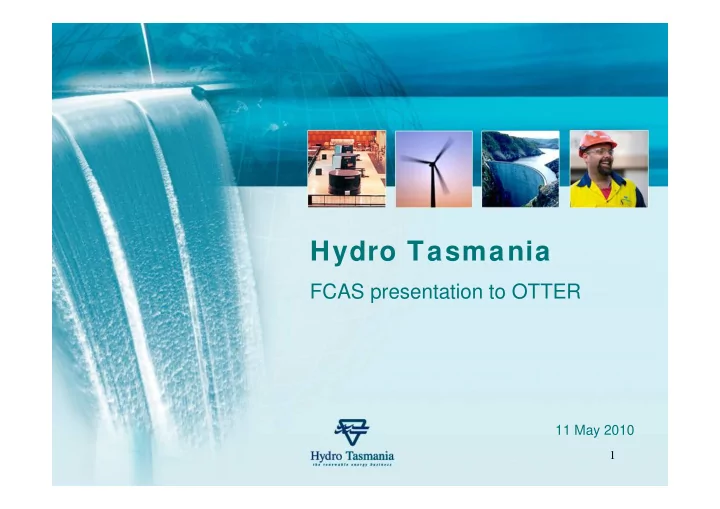

Hydro Tasmania FCAS presentation to OTTER 11 May 2010 1
Contents • Hydro Tasmania’s proposal • Regulation of hedge contracts • OTTER’s criteria for assessment • Pricing principles – current methodology • Current pricing policy - worked examples • Capital cost for pricing principles Commercial in confidence slides have been removed 2
Hydro Tasmania’s proposal Hydro Tasmania proposes the following approach: • Not regulating the physical raise contingency FCAS product. • Approving pricing principles for raise contingency FCAS hedge products in Tasmania. • Approving the contract terms for the regulated product. • Providing a process of review for any participant which disagrees with a quoted price from Hydro Tasmania for raise contingency FCAS. • Setting the period of the price determination for 3 years. 3
Regulation of hedge contracts • The regulation of hedges is vastly more attractive than regulating the physical offers as they: – Do not interfere with the efficiency of the dispatch process. – Minimise the burden on both OTTER and Hydro Tasmania. – Deliver a product which is useful to participants in managing their FCAS risks. – Provide participants with medium term price signals 4
OTTER’s criteria for assessment Principles Physical Financial � � Be consistent with the National Electricity Objective; � ☯ Not be unduly onerous on Hydro Tasmania in its application; � � Have minimal impact, if any, on the wider National Electricity Market; and ☯ � Not require an amendment to the National Electricity Rules nor add complexity to the National Electricity Market dispatch process. � � Be fair and reasonable; � � Enable Hydro Tasmania to recover its costs for the efficient provision of the declared electrical services; � � Provide market signals that promote efficiency and maximise incentives for other parties to supply raise (if above new (if above new contingency FCAS in the Tasmanian region; and entrant) entrant) � � Not impose significant regulatory costs on the Regulator or Hydro Tasmania. 5
Pricing principles – current methodology • Based upon short run costs – HT requirement supplied from least cost supply – Critical inertia level met – allocated proportionally • Key assumptions – R6 requirements – Competitor generation – Basslink flow – Hydro Tasmania efficient merit order - energy • Cost components – Inertia – synchronous condenser – Operational inefficiencies 6
Current pricing policy - worked examples Two major cost elements • Inertia – synchronous condenser – Critical quantum – Number of start/stops of machines – Median Vic price – REC price – Allocation methodology – proportional to participant generation levels • Operational inefficiencies – Stations impacted – Hours operation – Value of water foregone – Allocation methodology – sourced own liability first 7
Allocation methodology $/MWh R6 req’mt Supply Curve MW HT liability Non HT liability 8
Capital costs for pricing principles • Generators often bid FCAS to achieve energy outcomes rather than recover FCAS costs, but if FCAS is regulated as a separate market this must be disregarded. • 19 power stations enabled for FCAS raise contingency services. • 15 machines can operate in synchronous condenser mode providing inertia contribution. • Almost all assets for generation of energy and FCAS are common. • Inertia uses energy generation assets. • Raise contingency services provided concurrently with energy. 9
Capital costs for pricing principles (cont) • Methodology for cost allocation unclear – Option 1: (lost efficient output/total efficient output)*Depreciated Replacement Cost (DRC) – Option 2: replace short run marginal cost (water value) with long run average cost in existing formula • Either approach requires determination of DRC • Hydro Tasmania’s DRC asset value is large: – insurance value of Hydro Tasmania’s assets is $5.3 billion (depreciated) – compared to balance sheet value of $4.1 billion (depreciated) • Need to create regulatory accounts – onerous and expensive exercise 10
Capital costs for pricing principles (cont) • Option 2 suggests 80% or greater increase in cost of raise contingency compared to current methodology • Costs of regulation unknown, but likely to be disproportionately large compared to total service cost of $4.5 million per annum on current methodology • Capital and regulatory costs may increase cost of raise contingency services to the extent that there is no public benefit from regulation 11
IES Requests • Request 1. Provided on 11 May • Request 2. – Initial response provided in this presentation. – Has this presentation demonstrated the issues of your concern? 12
Summary • Regulating hedges meets OTTER’s criteria best • Pricing policies require multiple assumptions • FCAS costs can vary significantly • Capital costs are very hard to incorporate • What further information/discussions are required? 13
14
Recommend
More recommend